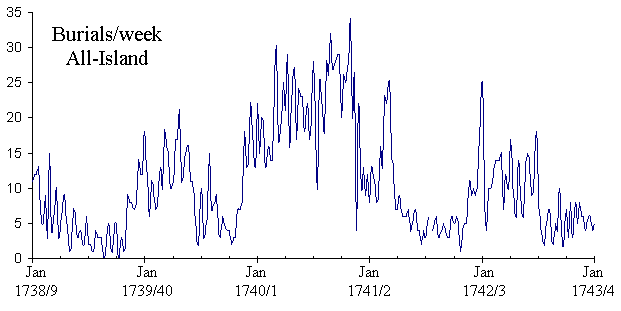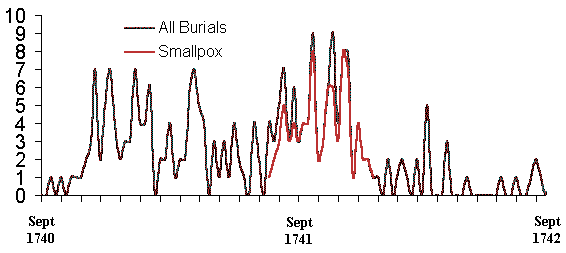
Wrigley & Schofield describe the English demographic crisis of 1741/2 as '3-star' quality - there being little crisis mortality in 1740 and the first half of 1741, the first surge in July 1741 corresponded to an exceptionally hot summer; local crises followed this, the descriptions of which vary, but generally involve 'fevers of the bilious kinds'. They suggest that dysentery rather than typhus was the major factor behind the heavy mortality in these years.
The all-island aggregated weekly burial totals are shown below

To avoid potential confusion I will adopt new style calendar style - Jan 1738/9 will be taken as the start of 1739 - the above plot shows weekly burials, derived from the indices to the various parish burial registers, for 1739,1740, 1741,1742 and 1743. The expected weekly burial rate should show some significant seasonal variation, rising with the onset of winter and possible food shortages and then falling from late spring to autumn as food becomes more available.
The summer of 1739 was a very dry one, Bishop Wilson describing it as the " severest drought " that he ever remembered - this led to a very poor harvest and a much reduced hay crop needed to feed animals during the winter, the winter of 1739-40 was very cold, and the harvest in 1740 was again a poor one. Moore in his history describes some of the measures taken , both public and privately by Bishop Wilson, to ameliorate the situation.
Many of the deaths in 1741 appeared to be due to a smallpox epidemic in Malew - German saw an epidemic of 'flux' in 1740 and a significant dip in conceptions from late summer of 1742. There was a significant number of deaths of children in Arbory in summer 1741 though the burial register has no comment on them.
The Malew Burials are shown below - burials are per week commencing 1 Sept 1740:

the smallpox epidemic of 1741 is shown in red and dominates the burials for late 1741 - these burials are indicated as such in the register and are all children, the large number of burials in the previous year attract no comment in the register - many of those who died in the part of this period appear to be adult (often with adult children judging from wills) but apart from two sisters any disease does not appear to be contagious. The later peak in mid 1741 seems to have more children [detailed statistics tbd]
R.A. Houston The Population History of Britain and Ireland 1500-1750, Macmillan Education Studies in Economic and Social History (ISBN 0-333-56564-9) 1992
E. A Wrigley & R.S. Schofield The Population History of England 1541-1871 A Reconstruction Cambridge: University Press (ISBN 0-521-35688-1) 1989
|
|
||
|
|
||
|
Any comments, errors or omissions gratefully received
The Editor |
||